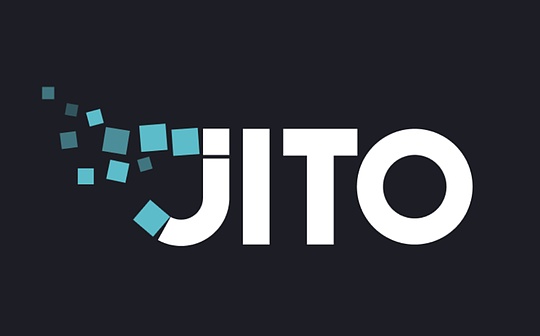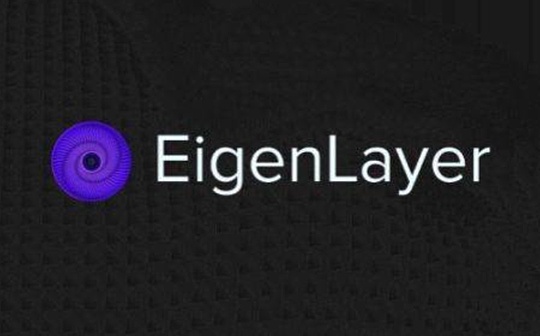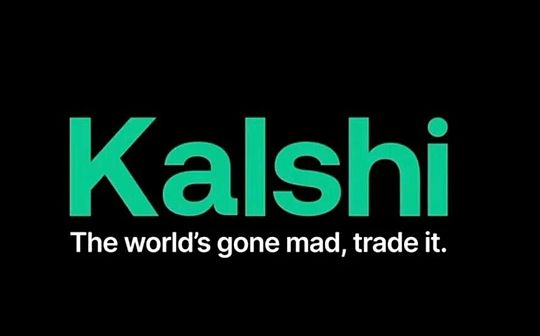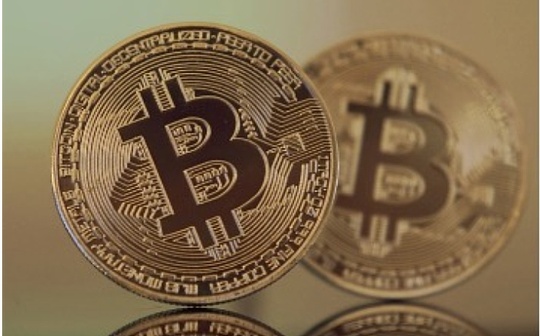
Written by: Lostin, Helius; Compiled by: Glendon, Techub News
If you hold SOL tokens and want to stake it, but don’t understand Solana’s staking mechanism?Don’t worry, this guide will provide you with a comprehensive overview of SOL staking covering the most common issues and all key areas.Let’s get started!
Why pledge SOL?
Staking SOL is not just for rewards—it is also crucial to Solana’s decentralization and security.Through staking, SOL token holders can contribute to the stability and governance of the network.In this process, it is very important to choose a suitable Validator for staking.Delegating tokens to validators is like voting in a representative democracy, which reflects the trust that the validators can maintain a high degree of online and process blocks quickly and accurately.Other considerations include the ethical behavior of the validator, response to hard forks, and contribution to the Solana ecosystem.
The rational allocation of pledge rights between reputable validators can further promote the decentralization of the network and effectively prevent any single well-funded entity from manipulating consensus decisions for personal gain.
What happens when you pledge it?
There are two forms of pledge on Solana: native pledge and liquid pledge.Currently, 94% of pledged SOLs adopt native pledge, so this article will focus on this form and briefly introduce liquid pledge in the future.For native staking, users can operate through a variety of platforms, including multi-signature fund management tools such as Squads, popular wallets, and dedicated staking sites.The process of performing native staking is relatively simple: the user simply deposits his tokens into the staking account and then delegates it to the voting account of the verifier.A single user can create multiple pledged accounts, each with the flexibility to delegate to the same or different validators.
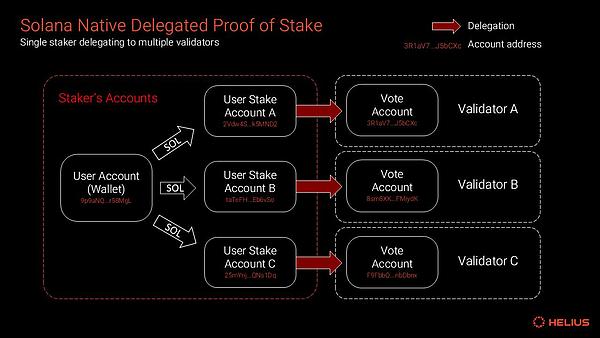
Above: A single staker delegates to multiple validators
Each pledged account has two key permissions: pledge permission and withdrawal permission.These two permissions are automatically set by the system at the beginning of the account creation and are assigned to the user’s wallet address by default.Each authority has its own clear responsibilities.Withdrawal permission has higher control over the account, it has the right to remove tokens from the staked account and allows users to update the allocation of staked permissions.
The most important time unit in staking is epoch.Each epoch in Solana lasts 432,000 slots, which is about two days.Whenever a new epoch is turned on, the system will automatically issue pledge rewards to the corresponding pledgers.This process does not require manual operation by the stakeholders, and they will see their account balance increase at the end of each epoch.In addition, users can directly receive MEV rewards through the Jito website (more on this later).
When you stake SOL in a native way, your tokens will be locked for the duration of the current epoch.If the user cancels the stake at the beginning of the epoch, it may take up to two days of cooling-off to withdraw.And if they withdraw at the end of the epoch, the process will be almost instant without additional waiting.
Similarly, starting a pledge also requires a warm-up period, which may last for two days or may be almost instant, depending on the time the user initiates the pledge account.During this process, users can check the Solana block browser to track the progress of the current epoch.
How do operators make profits?
Verifier operators mainly make profits in three ways:
-
Issuance/Inflation: Issuance of New Tokens
-
Priority Fee: Users send SOLs to validators to prioritize their transactions
-
MEV Reward: User pays Jito tips to the validator to include transaction packages
The revenue of the verifier is all denominated in SOL, and its revenue scale is directly linked to its pledge volume.Operating costs are mostly fixed and are denominated in a mixed form of SOL and fiat currency.
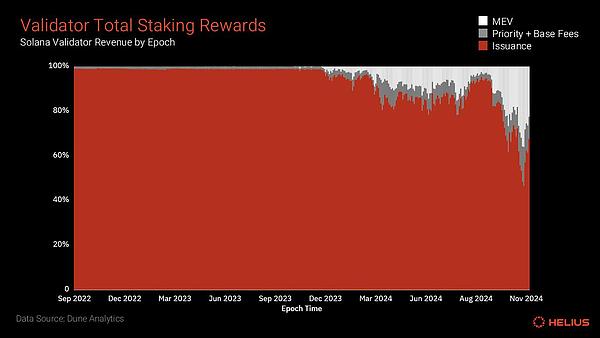
Above: Solana Verifier Total Staking Reward (Data Source: Dune Analytics, 21.co)
Token Issuance
Solana regularly issues new SOL tokens under the inflation plan and assigns these tokens to the validator as staking rewards at the end of each epoch.Currently, Solana’s inflation rate is 4.9%, which will decrease by 15% year by year until it finally stabilizes at the long-term inflation level of 1.5%.
The amount of pledge rewards received by the validator mainly depends on the number of points it receives by becoming an on-chain block node through the correct voting.If the validator is shut down or fails to vote in time, the points it receives will be reduced.With the average number of points, a validator with 1% of the total pledge is expected to receive a reward of approximately 1% of the total inflation.
In addition, the staking rewards of the validator will be further segmented and allocated according to the scale of the stakeholder’s delegation.In this process, the validator can charge a certain proportion of commission for the total inflation rewards it receives from its stakeholder.This commission rate is usually a single-digit percentage, but can be anything between 0% and 100%.

Above: Solana inflation schedule
Priority Fees
In the Solana network, validators selected as current block builders charge fees from each transaction processed, which are divided into two types: basic fees and priority fees.These fees are immediately credited to the Verifier’s identity account.Prior to this, the validator can obtain 50% of the rewards for each base fee and priority fee, and the remainder will be destroyed.With the adoption of SIMD-96, this fee structure is coming soon, and block producers will be allowed to receive 100% of the priority fees.
By paying a priority fee, it is possible to ensure that its transactions are processed first in the block.This mechanism is particularly important in a variety of scenarios, including arbitrage, clearing and NFT casting, which often have extremely high requirements for transaction speed.Because complex transactions consume more computing power, they often require higher priority fees.Generally speaking, popular token accounts with high demand require higher priority fees.
Compared with priority fees, although the income contribution of basic fees is relatively small, it plays an indispensable role in blocking spam.To maintain network security and stability, the Solana system fixes the basic fee to 0.000005 SOL (5000 lampors) per signature, thereby reducing the risk of malicious transactions and network congestion.
MEV (Jito) Rewards
Currently, the validators operating Jito Verifier Clients account for more than 90% of the total SOL staking.Jito introduced an off-protocol block space auction mechanism, which takes place off-chain, allowing searchers and applications to submit transaction groups called bundles.These bundles usually contain time-sensitive transactions, such as arbitrage or liquidation.To incentivize block builders to prioritize these transactions, each bundle comes with a “tip”.This provides the validator with additional revenue streams in addition to priority and basic fees.
In 2024, Jito’s MEV revenue has grown from a trivial amount to a major revenue source for validators.For validators, they can use a mechanism similar to inflation rewards to set up and charge their MEV commissions.The staker also allocates the remaining expenses based on the relative size of his delegation to the block builder.
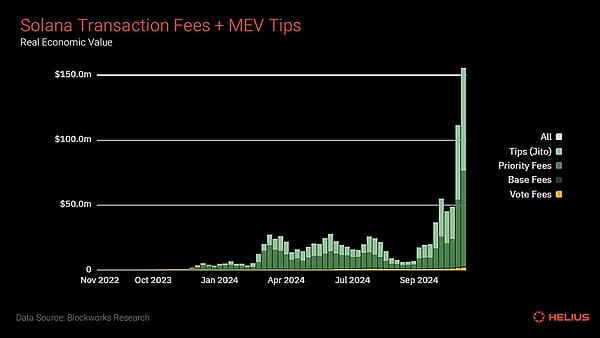
Above: Data on quantifying priority fees and Jito tip growth.Data source: Blockworks Research
Where does APY come from?
Annualized rate of return (APY) is an important indicator for measuring the annualized compound percentage rate of return that pledgers can obtain when pledging their current interest rate for a full year.This yield is affected by a variety of complex factors, including but not limited to the current issuance rate of the network, the performance and uptime of the validator, the rewards given to the validator by the user, and the current pledge rate (i.e. pledge.the proportion of SOL in total).Currently, multiple websites provide a list of validators ranked by APY, with StakeWiz being one of the most comprehensive websites.
Specifically, the source of APY is mainly divided into two major parts: issuance rewards and MEV rewards.
Issuing Rewards
In the Solana network, the validator allocates staking rewards based on the size of its stakeholder delegation.When a validator allocates a reward, it will charge a certain proportion of service commissions, with the commission ratio between 0% and 100%.In addition, the rewards obtained by a validator do not depend solely on the scale of its stakeholder’s delegation, but are also closely related to its voting performance.Each successful vote will earn points for the validator, which are important basis for them to obtain rewards.
A well-managed validator generates higher rewards based on the following factors:
-
Minimum downtime: Verifiers won’t earn points during downtime because they can’t vote.
-
Voting in time: If validators continue to lag in consensus engagement, they may earn fewer points.
-
Accurate Voting: Points will only be obtained when votes are made on subsequently confirmed blocks.
MEV (Jito) Rewards
MEV rewards play an increasingly important role in the composition of pledge rewards.This growth is driven by growing on-chain transaction volume and the consequent arbitrage opportunities.In recent years, Jito MEV tips account for about 20-30% of the total rewards, greatly increasing the benefits of pledgers.Similar to issuing rewards, the validator charges a commission for MEV tips ranging from 0% to 100%.In addition, Jito also charges a 5% commission on all MEV-related revenues as a platform service fee.
Other considerations
However, when selecting a validator, the stakeholder is not only concerned with the commission ratio.While low commission validators may lead to higher direct returns, many people still tend to opt for high commission validators such as Coinbase, which is driven by factors such as supplier lockdown and regulatory arbitrage.For example, funds using Coinbase Custody usually have to be staked specifically on Coinbase’s validator.On the other hand, centralized exchanges also benefit from retail users’ prioritization of convenience over earnings optimization.For off-chain users, they may be insensitive to sub-standard returns, which gives exchanges greater flexibility in the rewards they offer.
Finally, new protocol mechanisms (such as SIMD-123) are designed to allow the validator to share block rewards directly with the stakeholder.If implemented successfully, this will provide an additional source of income for the stakeholder.
Key players in Solana staking ecosystem
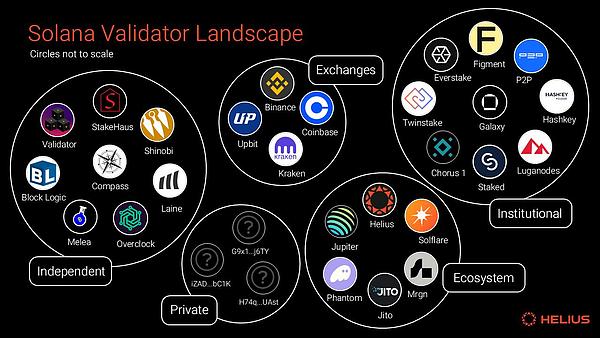
Solana validators can be divided into several categories.
Ecosystem team
Many well-known Solana application and infrastructure teams run validators that complement their core businesses.For example, Helius runs a validator to support its RPC service.
Example:
-
Helius
-
Mrgn
-
Jupiter
-
Drift
-
Phantom
Centralized exchange
Centralized exchanges are one of the Solana validators with the highest staking rate, providing one-click staking solutions for off-chain exchange customers.
Example:
-
Kraken
-
Coinbase
-
Binance
-
Upbit
Organizational Solution Provider
These companies specialize in providing customized pledge services to institutional customers.They support multiple blockchains to meet a wider range of customer needs.
Example:
-
Figment
-
Kiln
-
Twinstake
-
Chorus One
Independent team
Solana’s validator ecosystem includes many independently operated medium and long-tail validators.Some validators have been active since the creation of the web and contribute to the ecosystem through education, research, governance and tool development.
Example:
-
Laine
-
Overclock
-
Solana Compass
-
Shinobi
Private Verifier
The network also has over 200 private validators.Their stake is self-delegated and may be controlled by the operating entity.These validators are characterized by a commission rate of 100%, and the lack of public identity information on the block browser and dashboard.
What is liquid pledge?
Liquid staking allows users to spread their staking exposures between multiple operators through staking pools that are able to issue liquid staking tokens (LSTs) that represent the user’s ownership share in the underlying staking account.
LSTs
LSTs are income assets that accumulate rewards based on the annualized rate of return (APY) of the underlying pledged account.In native staking, each epoch reward will directly increase the SOL balance of the staking.Unlike native stakes, the number of LSTs remains unchanged in liquid stakes, but their value relative to SOL tokens will increase over time.
LSTs improve capital efficiency of staking by unlocking DeFi opportunities.A typical example is depositing LSTs as collateral on a lending platform, which allows users to lend while maintaining their positions and still receive pledge rewards.
Current status of liquid pledge
At present, although only 7.8% of SOL pledges adopt liquid staking, the growth rate of this part is very rapid.Data shows that liquid staking has accumulated 32 million SOLs, higher than 17 million at the beginning of 2024, with an annual growth rate of up to 88%.Among them, JitoSOL has become the most popular liquid staking token in Solana LSTs with its 36% market share. Other notable options include Marinade (mSOL) and JupiterSOL (jupSOL), accounting for 17.5% and 11% of the market, respectively..
Tax Advantages
In fact, liquid pledge also brings tax advantages to users.In many jurisdictions, pledge rewards issued in the form of tokens are considered taxable events, (similar to stock dividends) and taxed as income upon receipt.However, because the LSTs mechanism keeps the user’s wallet balance unchanged and only the value increases, the user will not trigger taxable events every time the reward is issued.
Is SOL pledge safe?
Native staking provides stakers with a direct and secure way to participate in the network verification process.In this way, the pledger always controls and keeps its SOL.If the validator is offline or performs poorly, the unmanaged staker has the right to unstake at any time and freely switch to other better performing validators.In the event of network outage, the position of the native staker will not be affected, and once network activity resumes, the position will remain unchanged.
Similarly, liquid pledge, as another option, also provides security in its unique way.Currently, five reputable companies have conducted nine audits of the pledge pool plan to ensure its robustness.Nevertheless, investors still need to pay attention to market volatility and potential risks when using liquidity staking.During adverse market conditions or “black swan events”, the trading price of LSTs may temporarily be lower than their underlying value.While these biases are often short-lived, investors should consider tail-end risks, especially when using LST as collateral.
Punishment mechanism
Slashing is a punishment mechanism that curbs malicious or harmful behavior by reducing entrusted stakes.尽管目前 Solana 尚未实施削减机制,但网络开发者正在积极考虑这一选项,并可能在未来引入。
Finally, stakers should abide by best practices and safely manage their private keys to prevent loss or stolen.
How is staking SOL different from staking ETH?
Solana and Ethereum are different in terms of staking methods.Solana integrates delegated proof of stake (dPoS) directly into its core protocols, enabling delegates without relying on external solutions.这一设计使得 Solana 的质押参与率高达 67.7%,占据了总供应量的显著比例,远高于以太坊的 28%。相比之下,以太坊从工作量证明过渡到权益证明的过程中,更多地依赖于 Lido 和 Rocket Pool 等第三方平台来提供委托和流动性质押服务。
On the other hand, on Ethereum, home staking is the only native staking option, which requires a high level of technical proficiency and dedicated hardware.验证器必须质押至少 32 ETH,并确保其硬件始终在线且得到充分维护。This self-hosting method has earned Ethereum a highly decentralized blockchain reputation, and thousands of home stakers have formed the basis of this network.
Although household staking occupies an important position in Ethereum, liquid staking has also been widely used through some major platforms.其中,Lido 在市场中占据领先地位,控制着超过 28% 的质押 ETH 供应量。Lido通过发行收益代币 stETH,使投资者能够在保持 ETH 持仓的同时享受质押奖励。然而,与所有流动性质押代币一样,stETH 也面临一些风险,包括智能合约漏洞和 stETH 价格偏离 ETH 等。更重要的是,以太坊的通胀回报相对较低,使用 Lido 质押 ETH 的年利率仅为 2.9%,远低于质押 SOL 的收益率。In addition, Lido’s 10% fee for pledge rewards also further reduces investors’ actual returns.
Finally, it is worthy of affirmation that Ethereum includes a cut mechanism to punish the wrong behavior of the validator, but cuts happen rarely.
in conclusion
This article comprehensively explores the concept, mechanism and importance of Solana staking, and is essential for experienced participants and newcomers who are new to the Solana ecosystem.Staking not only provides a way for long-term SOL holders to obtain competitive returns, but also is the core element supporting Solana’s basic mechanism for network security and decentralization.

